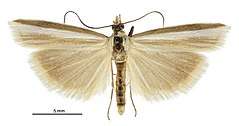Orocrambus jansoni
Orocrambus jansoni is a species of moth in the family Crambidae. It is endemic to New Zealand. This species is classified as "At Risk, Naturally Uncommon" by the Department of Conservation.
| Orocrambus jansoni | |
|---|---|
 | |
| Male | |
| Scientific classification | |
| Kingdom: | |
| Phylum: | |
| Class: | |
| Order: | |
| Family: | |
| Genus: | |
| Species: | O. jansoni |
| Binomial name | |
| Orocrambus jansoni Gaskin, 1975[1] | |
Taxonomy
This species was described by David Edward Gaskin in 1975 using a specimen he collected at Waiouru.[2][3] The holotype specimen is held at the New Zealand Arthropod Collection.[3]
Description
Gaskin described the species as follows:
Frons conical. Eye without nude circumorbital strip. Female frenulum triple. Wingspan (male) 18-22 mm, (female) 22 mm. Antennae dark brown, serrate in male, near filiform in female. Maxillary palpi triangular, brown laterally, yellowish medially. Labial palpi dark brown laterally, yellowish medially, porrect, about 2.4 x as long as head. Thorax and abdomen yellowish to silvery white. Forewings with brown costal streak from base to apex, similar paler streak on dorsum, median area silvery white to yellowish from base to termen, anterioi end of this fascia touching acute apex, cilia brown and white; hindwings dark brown with lighter brown cilia (holotype and paratype males). Allotype female very similar but with all markings very much paler and cilia of all wings white. Male frenulum single. Legs brown speckled with white in both sexes.[2]
Distribution
This species is endemic to New Zealand.[1][4] It has been recorded from the central part of the North Island, east of Mount Ruapehu.[2][5]
Biology and behaviour
O. jansoni are active during the day.[6] Adults have been recorded on the wing from December to February.[2] The female of the species is a more reluctant flier than the male.[5] The species has been trapped with ultra-violet light as well as mercury vapour lamp traps.[5] It has also been collected by netting or sweeping likely grasses.[5]
Host species and habitat
The host species of this moth is unconfirmed but it has been hypothesised that it is likely Rytidosperma pulchrum as females of the species have been discovered at the base of this plant.[5][7][8] O. jansoni is known to inhabit roadside grasslands along the Desert Road north of Waiouru,[7] and has also been collected at the Rangitaiki Frost Flats.[5] It is likely that it also inhabits New Zealand Defence Force land around Waiouru.[5] It prefers open grassland habitat.[5]
Conservation Status
This species has been classified as having the "At Risk, Naturally Uncommon" conservation status under the New Zealand Threat Classification System.[9]
References
| Wikimedia Commons has media related to Orocrambus jansoni. |
- "Orocrambus jansoni Gaskin, 1975". www.nzor.org.nz. Landcare Research New Zealand Ltd. Retrieved 2018-01-21.
- Gaskin, D. E. (1975). "Revision of the New Zealand Crambini (Lepidoptera: Pyralidae: Crambinae)". New Zealand Journal of Zoology. 2 (3): 265–363. doi:10.1080/03014223.1975.9517878.
- Dugdale, J. S. (1988). "Lepidoptera - annotated catalogue, and keys to family-group taxa" (PDF). Fauna of New Zealand. 14: 148. Retrieved 25 May 2018.
- Gordon, Dennis P., ed. (2010). New Zealand inventory of biodiversity. Volume two. Kingdom animalia : chaetognatha, ecdysozoa, ichnofossils. Vol. 2. Christchurch, N.Z.: Canterbury University Press. p. 457. ISBN 9781877257933. OCLC 973607714.
- Patrick, B; Patrick, H (2013). "Ecological observations of the eastern Volcanic Plateau endemic grassmoth Ororcrambus jansoni". The Weta. 46: 13–19.
- "Orocrambus fugitivellus". Manaaki Whenua - Landcare Research. Landcare Research New Zealand Ltd. Retrieved 2018-05-25.
- Patrick, Brian; Dugdale, John S. (2000). Conservation status of the New Zealand lepidoptera (PDF). Wellington, N.Z.: Department of Conservation, New Zealand. p. 28. ISBN 978-0478218671. OCLC 154670803.
- "PlantSynz - Invertebrate herbivore biodiversity assessment tool: Database". plant-synz.landcareresearch.co.nz. Retrieved 2018-07-11.
- Hoare, R.J.B.; Dugdale, J.S.; Edwards, E.D.; Gibbs, G.W.; Patrick, B.H.; Hitchmough, R.A.; Rolfe, J.R. (2017). "Conservation status of New Zealand butterflies and moths (Lepidoptera), 2015" (PDF). New Zealand Threat Classification Series. 20: 8.